📌 Quick Summary
Knockoffs eating your lunch on Amazon? Here's the twist: fight fire with fire by launching a cheaper version of your own product—yes, a self-knockoff. It sounds shady, but it's genius (and totally legal). This article breaks down how and why it works.

❓ Common Questions & Answers
Q1: Isn’t making a knockoff of my own product just cannibalizing my sales?
A1: Only if done wrong. When executed strategically under a different brand, it captures the low-end market while protecting your premium offering.
Q2: Is it legal to sell under multiple brands on Amazon?
A2: Yes. Many companies operate multiple private label brands to target different market segments.
Q3: Won’t this confuse customers or hurt my main brand?
A3: Not if you position them distinctly—different branding, pricing, packaging, and perceived value.
Q4: Why not just lower the price of my original product?
A4: Lowering your flagship product’s price erodes brand equity. A separate knockoff lets you compete without devaluing your core brand.
Q5: How do I make a knockoff that still feels legit?
A5: Use slightly less expensive materials or limit features while retaining your core functionality.

📜 Step-by-Step Guide
Step 1: Identify Your Core Product's Knockoff Vulnerability
Look at what makes your product ripe for copying—price, popularity, simplicity—and plan to mirror it strategically.
Step 2: Create a Secondary Brand Identity
Develop an entirely new brand with unique packaging and tone. It should appeal to budget-conscious buyers.
Step 3: Tweak the Product (But Keep the Essence)
Simplify the design, use cheaper components, or strip non-essential features while maintaining decent quality.
Step 4: Launch & List Separately on Amazon
Use different images, keywords, and tone to differentiate the listings. Don’t cross-promote.
Step 5: Monitor Performance and Adjust Accordingly
Track how each listing performs, adjust pricing, and scale up the one that wins over the bargain hunters.
📖 Historical Context
The concept of internal competition isn’t new. In the 1980s, car companies like Toyota launched sub-brands like Lexus to separate luxury from economy without cannibalizing either. This tiered branding model now thrives in industries from fashion to food.
Amazon’s private-label ecosystem has only intensified this trend. Companies like AmazonBasics and Solimo allow Amazon itself to undercut premium brands—its own included—in multiple categories. Sellers learned to adapt or disappear.
What changed recently is that knockoffs have gone global, fast, and furious. With manufacturers selling direct, brand owners had to either fight in court or fight in-store. Guess which one scales better?

🏢 Business Competition Examples
1. Anchor vs. Eufy (Anker’s Own Budget Brand)
Anker sells Eufy smart home gadgets at lower price points to compete with budget-oriented Amazon shoppers.
2. Procter & Gamble’s “Basic” Variants
P&G launched budget-friendly versions of its core products (e.g., Tide Simply Clean) to compete in lower-margin markets.
3. AmazonBasics vs. Everyone (Including Themselves)
Amazon undercuts name-brand items—and sometimes its own offerings—with generic, functional knockoffs.
4. Luxottica’s Tiered Eyewear
Luxottica owns premium brands like Ray-Ban but also markets value-tier brands under separate names to dominate all price levels.

💬 Discussion Section
Let’s not sugarcoat it—competing with counterfeiters sucks. They don’t invest in R&D, branding, or customer service. They just slap your idea on a cheaper mold and poach your buyers. But here’s where the self-knockoff strategy shines.
Creating a “clone” brand allows you to set the rules of the price war. You're no longer reacting; you're orchestrating. With strategic design tweaks and differentiated marketing, you can occupy two price tiers and edge out both counterfeiters and competitors.
The trick is psychological. Shoppers on Amazon don’t just compare specs—they compare perceived value. A $49 premium version and a $24 budget-friendly version both meet different needs. Think of it as Jekyll and Hyde, but both versions send profits to the same bank account.
Also, it insulates your brand. If your premium product suddenly dips in quality or price, customers get suspicious. But if your second-tier brand is designed to look and feel cheaper, it delivers on expectations—no backlash.
Lastly, it’s a scalable model. Once you’ve mastered the art of dual-brand warfare, you can replicate it across categories, dominating the search results with every flavor of your own idea.

⚖️ The Debate
✅ Pro Self-Knockoff Side:
-
Controls multiple market segments
-
Preempts copycats
-
Increases brand resilience
-
Flexible pricing strategies
❌ Against Side:
-
Brand dilution risks
-
Complex inventory & logistics
-
Customer confusion if not well-differentiated
-
Ethical concerns around transparency
✅ Key Takeaways
-
Competing with knockoffs? Be your own knockoff.
-
Use a secondary brand to target price-sensitive buyers.
-
Differentiate products to avoid cannibalization.
-
Control both premium and bargain spaces on Amazon.
-
Strategic self-cloning can outmaneuver shady imitators

⚠️ Potential Business Hazards
-
Accidentally confusing or cannibalizing your main brand
-
Legal risks if the products share too many identical elements
-
Operational strain from managing two supply chains
-
Negative reviews bleeding from one brand to the other
❌ Myths & Misconceptions
-
“It’s illegal to compete with yourself.” Totally false. As long as your products are differentiated, it’s fair play.
-
“Customers will find out and feel betrayed.” Only if you make it obvious.
-
“Amazon won’t allow it.” They allow multiple brand accounts if you follow their rules.
-
“You need a big team to manage two brands.” Not necessarily—automation tools help.
-
“Only big brands can pull this off.” Small sellers do it every day (and profit wildly).

📚 Book & Podcast Recommendations
-
The Everything Store by Brad Stone – https://www.amazon.com/dp/0316219266
-
Contagious: Why Things Catch On by Jonah Berger – https://www.amazon.com/dp/1451686587
-
My First Million Podcast – https://www.mfmpod.com
-
Smart Passive Income with Pat Flynn – https://www.smartpassiveincome.com/shows/spi/
⚖️ Legal Cases
-
Amazon vs. Counterfeiters (2021)
https://www.aboutamazon.com/news/company-news/amazon-and-goodyear-file-lawsuit-against-counterfeiters
Amazon collaborates with brands to crack down on knockoffs—showing the need to get ahead with your own strategy. -
OtterBox v. Generic Sellers
https://www.reuters.com/article/us-otterbox-lawsuit-idUSKCN0JF0DC20141202
OtterBox sued third-party sellers for knockoffs; their struggles underline the value of proactive counter-strategies. -
Levi Strauss & Co. v. Abercrombie & Fitch
https://law.justia.com/cases/federal/appellate-courts/F3/266/853/594693/
A classic case about brand identity confusion—relevant when designing your own self-knockoff.

📣 Expert Invitation
Got experience cloning your own brand or fighting off counterfeits? We'd love to hear your story or feature your insights in our next post.
👉 Drop us a line at http://inventiveunicorn.com
🔚 Wrap-Up Conclusion
In today’s Amazon jungle, survival isn’t about playing fair—it’s about playing smart. When knockoffs come for your throne, show them who's boss by knocking off... yourself. It’s not selling out. It’s selling smart.












